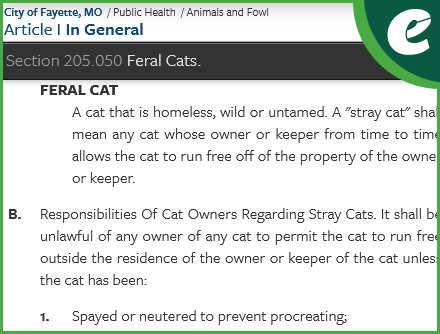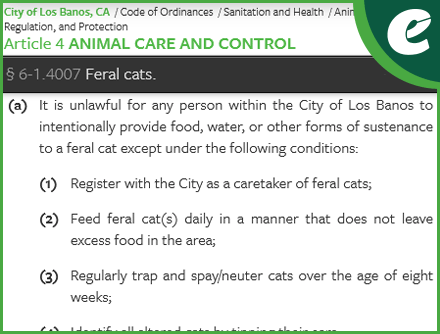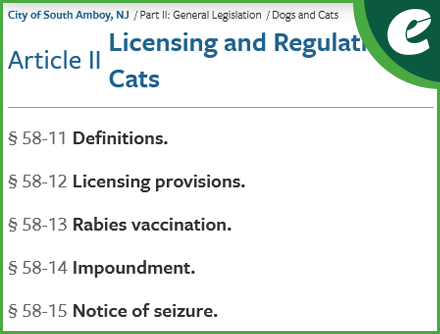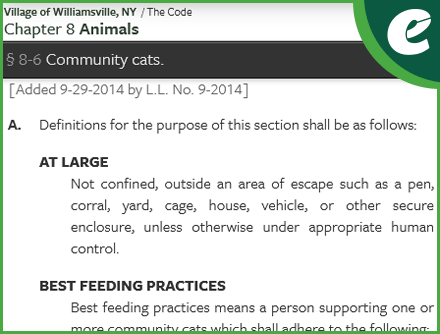There’s no doubt that cats rule the internet and have warmed the hearts of humans around the world for centuries. But while seeing them in memes can be highly entertaining and having them choose your lap to sleep on is like winning the lottery for many of us, having them attack the birds in our backyards or leave strong odors and excrement in our gardens is not nearly as endearing. Cats that stray or live in feral conditions can cause havoc for the neighborhoods where they live and roam. Finding solutions to alleviate the issues associated with feral cat populations is largely left to local government.
View sample feral cat legislation >
A tale of two types of cats
Stray or feral – is there a difference and does it matter? Yes and yes. Ownerless cats may appear the same but a primary difference between a stray cat and a feral one is the socialization factor: the ability, need, or desire to interact with humans.
A feral cat is born and lives in the wild with little or no human contact. They will be very independent, avoiding human contact, performing most of their activities during the evening or nighttime, and will rarely, if ever, beg or vocalize (purr or meow). Of the 700 million cats in the world, an estimated 480 million are feral.
A stray cat may be presently homeless, but was once a pet that lived with humans. They will be more willing to approach humans, be petted, accept food and water, and with care and patience, may be re-acclimated to live inside.
Why is it important to make this distinction? Because the methods for handling a feral cat population can be very different from dealing with the challenges of stray cats.
Claws for concern
Estimated to number between 60 and 100 million in the United States, unowned, free-ranging felines are associated with a variety of problems related to humans and animals.
- Disease
While stray cats may receive some medical assistance from concerned residents, truly feral cats are generally not treated by owners or veterinarians and therefore can carry contagious diseases like flea-borne typhus and rabies, and parasites like hookworm and fleas which can affect pets, humans, and other animals. - Declining biodiversity
Outdoor cats (owned, stray, or feral) are skilled hunters. In the United States alone, statistics suggest that cats kill 1.3–4 billion birds, and that 69% of these are killed by stray or feral cats. Additionally, 6.3–22.3 billion mammals are killed each year by free-roaming cats. - Vermin
While feral cats hunt, they do not completely control populations of mice and rats, especially if food left for feral cats is available. Not only do the feral cats have access to the food, these rodents will also eat it and will continue to reproduce due to the availability of a food source. - Mosquitoes
Because birds and bats are major consumers of mosquitoes, feral cats also contribute to increased rates of mosquitoes and mosquito-borne diseases such as Zika, West Nile Virus, malaria, etc., due to their successful hunting abilities.
Finding the purr-fect solutions
Keeping in mind that intentional harm or killing of feral cats is considered a criminal offense in all 50 states and the District of Columbia, regardless of ownership status, alternative methods of controlling feral and stray cat populations must be explored. Adopting ordinances that give guidelines to cat owners and those interested in protecting and caring for unowned felines can help to dramatically improve the situation for all involved.
One of the more popular programs is “trap-neuter-release” (TNR). This is a long-term approach that works to gradually decrease the feral/stray breeding cycle by capturing cats, spaying or neutering them, sometimes vaccinating them at the same time, and “eartipping” to identify that the cat has already been through of the TNR process.
Additional legislative methods employ a variety of tactics to protect feral or stray cats, while being mindful of citizens who may experience some of the negative aspects of these animal populations. Legislation can address topics including, but not limited to:
- Animal cruelty – defining a process for reporting, enforcement duties, and penalties.
- Ownership – making a distinction between an owner and caretaker (especially where a feral cat colony exists). This provides good Samaritans with protections and parameters as they attempt to provide basic care.
- Outdoor shelters and feeding – establishing standards for shelters (location, construction) and fixing strict guidelines for feeding (hours, facilities, sanitation).
- At-large regulations – sometimes referred to as “leash laws” in municipal codes, these ordinances restrict or ban cats (feral or owned) from roaming freely.
- Licensing requirements – mandating that cats are registered with the community and wear tags to identify them as licensed.
When considering these or other legislative remedies to manage feral or stray cats, many municipalities find it useful to engage local animal welfare organizations, veterinary professionals, and animal rehabilitators for their expertise and input.
Useful examples of feral cat legislation from the eCode360® Library
If your community is interested in enacting feral cat legislation, here are some useful examples that can be found in our eCode360 Library:
Updating your municipal code is vitally important
Did you know you can set up a regular update schedule, so you don’t have to worry about compiling materials or taking up time and resources of your staff to do the updates yourself? As your municipality passes legislation, send it to General Code and we’ll take care of the rest. It’s just that simple!
For tips that will allow us to process your code updates most efficiently, click here.
Questions about updating your code?
Our Client Care team is available to explain the options and benefits of scheduled code updates or any other code-related questions you might have.
Sources:
- Managing Feral Cats
- Feral or Stray – An Important Difference
- Feral cat (Wikipedia)
- Feral Cats and Their Impact in Communities
- Stray vs Feral Cats – What you Need to Know
- FAQ: Outdoor Cats And Their Effects On Birds
- Free-Ranging and Feral Cats
- Cats and the Law: Local Laws and Ordinances
- How to Draft a Lifesaving Cat Ordinance with Trap-Neuter-Return
- Feral and Stray Cats: An Important Difference
- Feral Cat Laws by State 2024
- Colony Management – Caring for Your Colony
- Community Cats & The Law
- The Best Ways to Help Feral Cats
- The impact of free-ranging domestic cats on wildlife of the United States
- Pet Ownership Statistics 2024
- eCode360® Library of municipal codes






